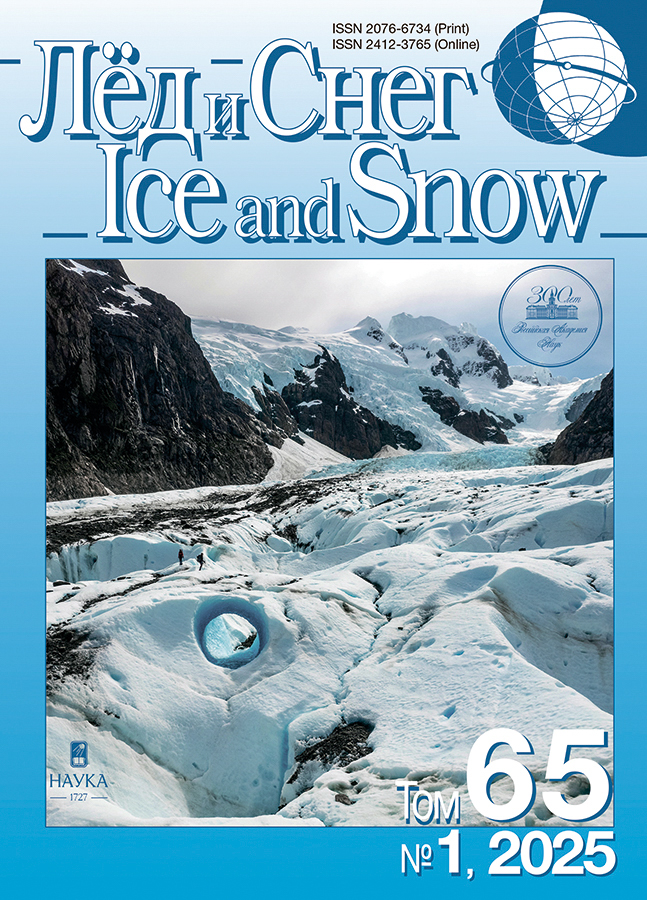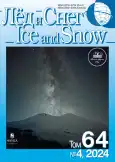Mass balance of IGAN Glacier (the Polar Urals) in 2018–2023
- Authors: Nosenko G.A.1, Muraviev A.Y.1, Shein A.N.2, Ivanov M.N.3, Lavrentiev I.I.1, Leopold J.K.2, Sinitsky A.I.2, Tokmakov V.V.4
-
Affiliations:
- Institute of Geography, Russian Academy of Sciences
- Scientific Center for Arctic Studies
- Lomonosov Moscow State University
- Techstroyproekt LLC
- Issue: Vol 64, No 4 (2024)
- Pages: 567-579
- Section: Glaciers and ice sheets
- URL: https://journal-vniispk.ru/2076-6734/article/view/282796
- DOI: https://doi.org/10.31857/S2076673424040074
- EDN: https://elibrary.ru/HTIDLX
- ID: 282796
Cite item
Full Text
Abstract
The results of observations of the mass balance of the IGAN glacier by the geodetic method using DGPS surveys and constructed multi-temporal digital models of the glacier surface (DEM) for the period 2018–2023 are presented. Comparison with data from previous years (1963, 2008, 2018) obtained using a similar methodology allowed to assess changes in glacier mass over the entire observation period and its features over the short span of the last five years. It was found that the glacier continues to shrink. In 2023, the area of its northern part was 0.43±0.04 km2, having decreased by 38% compared to 1963. From 2018 to 2023, the glacier surface dropped by an average of 3.73 m. During this period, the glacier lost 1.593 × 106 m3 of ice. The average annual specific mass balance was negative –627±45 mm w.e. This value is almost twice as high as in the period 2008–2018, when it was –372±63 mm w.e. The cumulative mass balance over five years reached –3134±224 mm w.e. The main cause that determines the glacier shrinkage throughout the entire observation period from 1963 to 2023 is the increase in summer air temperatures occurring on the background of practically unchanged winter precipitation. Along with this, it was found that the glacier lost less over the entire observation period (2018–2023) than in the last three balance years (2020-2023). A possible explanation for this could be the positive mass balance in 2019, in which the DGPS survey could not be conducted. To confirm this assumption, data from meteorological observations of air temperature, precipitation, snow measurement and monitoring of the snow line from satellite images at the end of the ablation period were used. Based on the analysis of these data, a conclusion was made that such a situation was possible due to the anomalous winter precipitation and cold summer in that specific year.
About the authors
G. A. Nosenko
Institute of Geography, Russian Academy of Sciences
Author for correspondence.
Email: nosenko@igras.ru
Russian Federation, Moscow
A. Ya. Muraviev
Institute of Geography, Russian Academy of Sciences
Email: nosenko@igras.ru
Russian Federation, Moscow
A. N. Shein
Scientific Center for Arctic Studies
Email: nosenko@igras.ru
Russian Federation, Salekhard
M. N. Ivanov
Lomonosov Moscow State University
Email: nosenko@igras.ru
Russian Federation, Moscow
I. I. Lavrentiev
Institute of Geography, Russian Academy of Sciences
Email: nosenko@igras.ru
Russian Federation, Moscow
J. K. Leopold
Scientific Center for Arctic Studies
Email: nosenko@igras.ru
Russian Federation, Salekhard
A. I. Sinitsky
Scientific Center for Arctic Studies
Email: nosenko@igras.ru
Russian Federation, Salekhard
V. V. Tokmakov
Techstroyproekt LLC
Email: nosenko@igras.ru
Russian Federation, Cheboksary
References
- Voloshina A.P. Some results of the mass balance studies of the Polar Urals glaciers. Materialy Glyaciologichkih Issledovanij. Data of Glaciological Studies. 1988, 61: 44–51. [In Russian].
- Ivanov M.N. Evolution of the Polar Urals glaciation in the late Holocene. Moscow: MSU Publishing House, 2013: 200 p. [In Russian].
- Katalog lednikov SSSR. USSR Glacier Inventory. V. 3. Northern Edge. Is. 3 Ural. Leningrad: Hydrometeoizdat, 1966: 52 p. [In Russian].
- Lavrentiev I.I., Nosenko G.A., Glazovsky, A.F., Shein A.N., Ivanov M.N., Leopold Ya.K. Ice and snow thickness of the IGAN Glacier in the Polar Urals from ground-based radio-echo sounding 2019 and 2021. Led i Sneg. Ice and Snow. 2023, 63 (1): 5–16. https://doi.org/10.31857/S2076673423010106 [In Russian].
- Nosenko G.A., Muraviev A.Y., Ivanov M.N., Sinitsky A.I., Kobelev V.O., Nikitin S.A. Response of the Polar Urals glaciers to the modern climate changes. Led I Sneg. Ice and Snow. 2020, 60 (1): 42–57. https://doi.org/10.31857/S2076673420010022 [In Russian].
- Nosenko G.A., Smirnov A.M., Lavrentiev I.I., Kutuzov S.S., Abramov A.A. Dinamika pokazateley balansa massy lednika Garabashi (El’brus) v usloviyakh sovremennogo klimata. The mass balance indicators dynamics of the Garabashi (Elbrus) glacier under modern climate conditions. Abstracts of All-Russian open conference “State of mountain glaciers in the context of modern climate change”. Nalchik, may 30–31. ISBN 978-5-907725-74-4. P. 23–24. https://vgistikhiya.ru/images/kart/Тезисы–31.05.pdf
- Troitsky L.S., Khodakov V.G., Mikhalev V.I., Guskov A.S., Lebedeva I.M., Adamenko V.N., Zhivkovich L.A. Oledenenie Urala. The glaciation of the Urals. Moscow: Nauka, 1966: 355 p. [In Russian].
- Toropov P.A., Aleshina M.A., Nosenko G.A., Khromova T.E., Nikitin S.A. Modern deglaciation of the altai mountains: Effects and possible causes. Meteorology and Hydrology. Meteorology and Hydrology. 2020, 5: 118–130. [In Russian].
- Shein A.N., Ivanov M.N., Nosenko G.A., Lavrentiev I.I., The study of IGAN, Anuchin and Photogeodesists glaciers in 2023. Scientific Bulletin of the Yamalo-Nenets Autonomous Okrug. Nauchny Vestnik Yamalo-Nenetskogo Autonomogo Okruga. 2024, 1 (122): 50–68. https://doi.org/10.26110/ARCTIC.2024.122.1.004 [In Russian].
- Tsvetkov D.G. 10 years of photogeodetic works on the glaciers of the Polar Urals (Experience of land surveying and mapping of small glaciers with the application of topograps of the IGAN and Obruchev glaciers at a scale of 1:5000. Materialy Glyatsiologicheskikh Issledovaniy. Data of Glaciological Studies. 1970, 16: 245–257. [In Russian].
- ArcticDEM. Retrieved from: https://www.pgc.umn.edu/guides/arcticdem/datadescription/
- Cogley J.G. Geodetic and direct mass-balance measurements: comparison and joint analysis. Annals of Glaciology. 2009, 50 (50): 96–100. https://doi.org/10.3189/172756409787769744
- ECMWF ERA5 (0.5×0.5 deg). Retrieved from: https://climatereanalyzer.org/reanalysis/monthly_tseries/
- Fischer A. Comparison of direct and geodetic mass balances on a multi-annual time scale. The Cryosphere. 2011, 5 (1): 107–124. https://doi.org/10.5194/tc-5-107-2011
- ISC(WDS)/IUGG(IACS)/UNEP/UNESCO/WMO, World Glacier Monitoring Service, Zurich, Switzerland. 274 p. Publication based on database version. https://doi.org/10.5904/wgms-fog-2019-12
- IPCC, 2023: Climate Change 2023: Synthesis Report. Contribution of Working Groups I, II and III to the Sixth Assessment Report of the Intergovernmental Panel on Climate Change [Core Writing Team, H. Lee and J. Romero (eds.)]. IPCC, Geneva, Switzerland. 2023: 184 p. https://doi.org/10.59327/IPCC/AR6-9789291691647
- Kouki K., Luojus K., Riihelä A. Evaluation of snow cover properties in ERA5 and ERA5-Land with several satellite-based datasets in the Northern Hemisphere in spring 1982–2018. The Cryosphere. 2023, 17 (12): 5007–5026. https://doi.org/10.5194/tc-17-5007-2023
- Korneva I.A., Toropov P.A., Muraviev A. Ya., Aleshina M.A. Climatic factors affecting Kamchatka glacier recession. International Journ. of Climatology. 2024, 44 (2): 345–369. https://doi.org/10.1002/joc.8328
- Popovnin V., Gubanov A., Lisak V., Toropov P. Recent Mass Balance Anomalies on the Djankuat Glacier, Northern Caucasus. Atmosphere. 2024, 15: 107. https://doi.org/10.3390/atmos15010107
- SENTINEL 2 Data Quality Report. ESA. Ref. S2-PDGS-MPC-DQR.Is.41.03/07/2019: https://sentinel.esa.int/documents/247904/685211/Sentinel-2_L1C_Data_Quality_Report
- Shahgedanova M., Nosenko G., Bushueva I., Ivanov M. Changes in area and geodetic mass balance of small glaciers, Polar Urals, Russia 1950–2008. Journ. of Glaciology. 2012, 58 (211): 953–964. https://doi.org/10.3189/2012JoG11J233
- Toropov P.A., Aleshina M.A., Grachev A.M. Large-scale climatic factors driving glacier recession in the Greater Caucasus, 20th–21st. International Journal of Climatology. 2019, 39: 4703–4720.
- Toropov P.A., Aleshina M.A., Nosenko G.A., Khromova T.E., Nikitin S.A. Modern deglaciation of the altai mountains: Effects and possible causes. Russian Meteorology and Hydrology. 2020, 45: 368–376.
- Zemp M., Gärtner-Roer I., Nussbaumer S.U., Bannwart J., Rastner P., Paul F., Hoelzle M. Global Glacier Change Bulletin. 2016–2017: 3.
- Zemp M., Gärtner-Roer I., Nussbaumer S.U., Welty E.Z., Dussaillant I., Bannwart J. WGMS 2023. Global Glacier Change Bulletin. 2020–2021: 5.
- ISC(WDS)/IUGG(IACS)/UNEP/UNESCO/WMO, World Glacier Monitoring Service, Zurich, Switzerland. 134 p. Publication based on database version. https://doi.org/10.5904/wgms-fog-2023-09
- Zemp M., Jansson P., Holmlund P., Gartner-Roer I., Koblet T., Thee P., Haeberli W. Reanalysis of multitemporal aerial images of StorglaciaЁren, Sweden (1959–99). Part 2: Comparison of glaciological and volumetric mass balances. The Cryosphere. 2010, 4 (3): 345–357. https://doi.org/10.5194/tc-4-345-2010
Supplementary files










